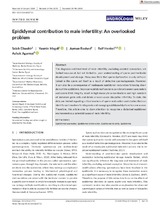| dc.description.abstract | The diagnosis and treatment of male infertility, excluding assisted conception, are limited because of, but not limited to, poor understanding of sperm post-testicular development and storage. Many may think that sperm dysfunction is only self-contained in the sperm cell itself as a result of defective spermatogenesis. However, it can also be a consequence of inadequate epididymal maturation following disorders of the epididymis. Improper epididymal functions can disturb semen parameters and sperm DNA integrity, result in high leucocyte concentrations and high numbers of immature germ cells and debris or even cause idiopathic infertility. To date, the data are limited regarding critical markers of sperm maturation and studies that can identify such markers for diagnosis and managing epididymal dysfunction are scarce. Therefore, this article aims to draw attention to recognise a disturbed epididymal environment as a potential cause of male infertility. | en_US |

